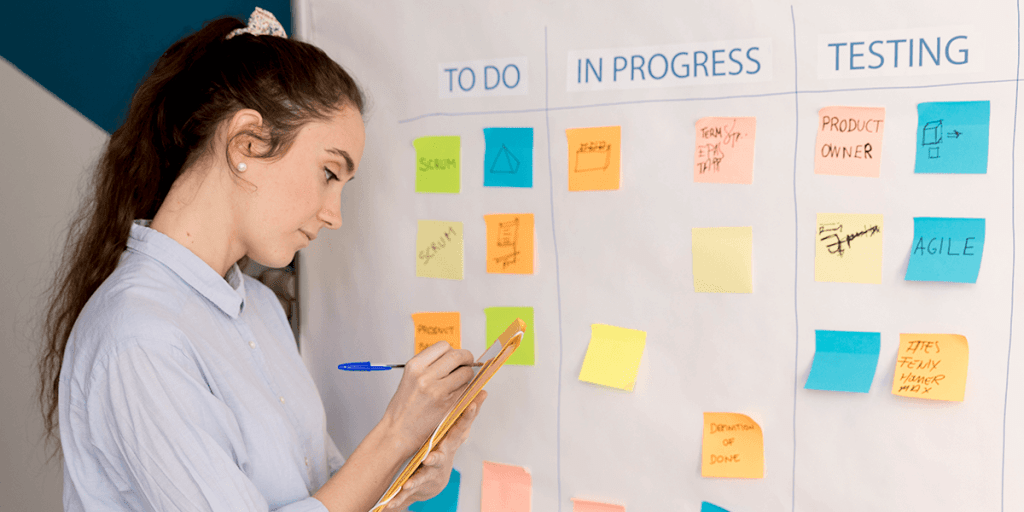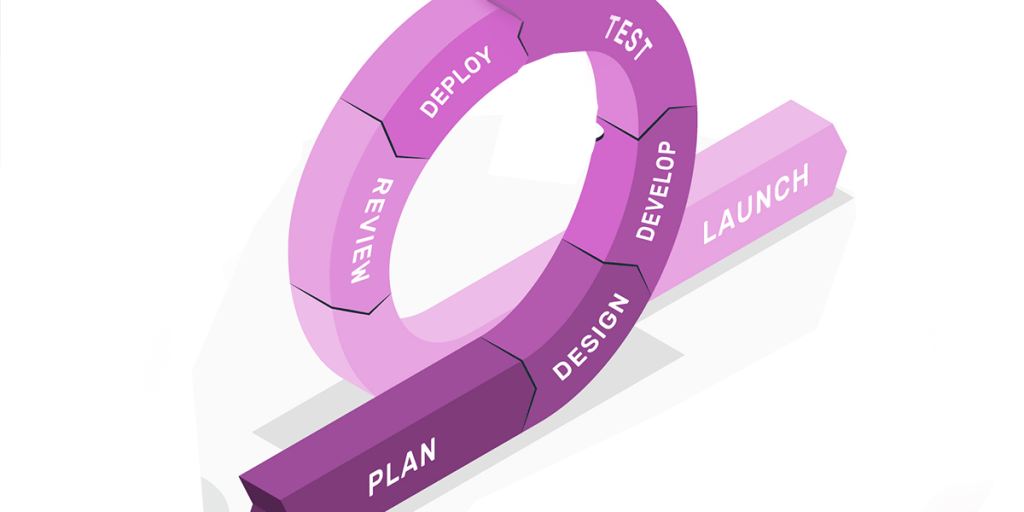How to Leverage Agile Methodologies in Custom Software Development for All Businesses Sizes
In a rapidly evolving technological environment, businesses pursue leveraging software applications that align with their workflows, objectives, goals and user experiences. Subsequently, custom software development has gained significant interest in implementing a personalised approach to software solutions.
Software development projects’ intricacy and fast-changing nature need an adaptive approach to reach business goals. Here comes at play the adoption of Agile methodologies to enhance the development process further, allowing businesses of all sizes to handle the complexities of software development swiftly and efficiently.
In this article, we will explore the nature of the Agile approach and how all-size businesses can leverage this method to improve the development process, improve collaboration, and deliver value to their customers by staying responsive to their demands. Furthermore, we asked our project managers to share their knowledge and ways to navigate Agile processes to ensure a smooth and productive development process.
What Are Agile Methodologies?

Adopting Agile methodologies enhances the process as custom software development plays a pivotal role in allowing businesses to leverage tailored-made solutions for their unique needs. It enables companies of all sizes to navigate the complexities of software development in an agile and effective way.
Software development projects’ fast-growing and ever-changing nature needs an adaptive and iterative approach to ensure success. 86% of international software developers use Agile. Agile methodologies such as Scrum, Kanban and Lean have proven to be highly effective frameworks for managing custom software development projects flexibly and collaboratively.
Agile methodologies’ core values and principles prioritise responsiveness, adaptability and constant improvement. Agile methods enable businesses to enhance software delivery efficiency, mitigate risks, and adeptly respond to evolving projects and business requirements by promoting iterative development cycles, frequent feedback loops, and close collaboration among project stakeholders.
The relevance of an Agile framework extends beyond the boundaries of business size because Agile principles can empower the showcase of development initiatives.
Let’s list the most popular approaches to software development that prioritise flexibility, collaboration and iterative progress with a focus on adaptive planning, early delivery of working software and continuous improvements:
Scrum Agile framework is widely used and involves self-organising teams that work in short iterations called sprints. It focuses on frequent feedback, regular meetings, and clear roles and responsibilities.
Kanban has a more visual approach to workflows and limits the work in progress. The Kanban board tracks tasks, and they move through different stages, providing a smooth and efficient workflow.
Extreme Programming, or XP, emphasises close collaboration and fast feedback loops, including practices like continuous integration, test-driven development, pair programming and regular releases.
Lean Software Development was inspired by lean manufacturing principles that aim to maximise value and minimise waste. It eliminates non-value-adding activities, focusing on continuous improvement and delivering software to the market as fast as possible.
Crystal methodologies focus on flexibility and adaptability based on the project’s unique characteristics and requirements. It offers different approaches, such as Crystal Clear for small development teams and Crystal Orage for large projects. Furthermore, it provides guidelines for communication, teamwork and process tailoring.
Fast-Driven Development, or FDD, promotes feature delivery and domain modelling by breaking down the development process into manageable feature sets and focusing on short iterations, frequent inspections and feature-level ownership.
The Agile approaches listed above are the most well-known and have been implemented across the industry. Each focuses on its own principles and practices. However, the common goal of each method is delivering high-quality software in a collaborative, iterative and adaptive manner.
Key Practices and Basic Principles of Agile Methodologies for Custom Software Development Projects

Implementing an Agile software development methodology is crucial for effective team collaboration, delivering high-quality software solutions while responding swiftly to changing requirements. The Agile software development approach for custom solutions involves key practices and basic principles such as:
- User stories for capturing software requirements from a user’s perspective. They are concise and written in simple language. Moreover, they focus on delivering value to end-users, prioritise and drive development efforts based on user needs.
- Iterative development to break down the project into smaller sprints that last a few weeks and allow continuous feedback, early validation and viable outcome delivery.
- Continuous Integration and Continuous Delivery (CI/CD) to ensure the code changes are integrated frequently, tested and deployed to the production environment.
- Daily stand-up meetings or daily scrum are short and focus on providing updates on the team’s progress, discussing critical issues and challenging issues or impediments.
- Sprint planning sessions to define the scope of work for the upcoming sprints, identify tasks and user stories that need to be worked on and estimate the effort required.
- Sprint Review and Sprint Retrospective happen at the end of each sprint and involve showcasing the completed work to business stakeholders. Furthermore, it helps to gather feedback and incorporate it into future iterations.
- Cross-functional collaboration is where team members with different skill sets and expertise work together on the project.
- Test-Driven Development (TDD) involves writing automated tests before writing the code to ensure that the software is built to meet the client’s requirements and enable teams to detect early or broader issues, improve code quality and maintain a robust test suite.
- Product Backlog is a prioritised list of user stories and features that represent the work to be done. The backlog is continuously refined and updated based on feedback, client input, changing priorities and emerging client requirements.
- Retrospective and continuous improvement to reflect on the development processes, identify areas for improvement and implement changes to enhance quality, productivity and teamwork.
Why Do We Consider Agile Development the Best Approach for Custom Software Development?
At the heart of Agile Methodologies stands the Agile Manifesto which outlines four key values and twelve principles, created by a group of software development practitioners in 2001.
The first key value is “Individuals and Interactions over Processes and Tools”. This emphasises the importance of effective communication and collaboration among team members, and it values the contributions of individuals and promotes close interaction to ensure project success.
The second key value is “Working Software over Comprehensive Documentation”. This focuses on delivering a functional product that meets the customer’s needs. The documentation is extremely important, but the focus is on the working software as a primary measure of progress.
The third key value is “Customer Collaboration over Contract Negotiation”. This encourages the customer’s involvement and collaboration throughout the development process. Engage customers and gather feedback to ensure that the software development teams and the final digital product meet expectations and add value to the client’s business and the customers.
The last key value is “Responding to Change over Following a Plan”. This means embracing changes as a natural part of the development process. The ability to adapt and adjust to changing requirements becomes a priority, which is essential to incorporate new ideas and insights as the project progresses.
We have decided to embrace the Scrum and Kanban Agile methodologies as they have revolutionised the software development environment by providing structured frameworks for managing projects flexibly and iteratively. Scrum focuses on the principles of transparency, inspection and adaptation by operating through a series of time-boxed iterations, also knowns as sprints, that typically last from two to four weeks. Each sprint begins with a planning session where the Agile development team collaboratively defines the work that must be completed during the iteration. Moreover, daily stand-up meetings facilitate communication and coordination and allow the team to discuss progress, challenges, upcoming tasks, etc. At the end of each sprint, a review and retrospected are organised to evaluate the work and identify gaps and areas for improvement. This approach focuses on self-organisation, cross-functional collaboration and delivering incremental value to the client.
On the other hand, Kanban focuses on visualising and optimising the workflow. It uses a board with columns representing different software development process stages. The work items are represented as cards that will be moved through the columns from left to right as they progress. This approach limits the work items in each column to prevent team overload and provide a smooth workflow. Kanban encourages the teams to measure and analyse the development process, identify bottlenecks and make changes to enhance efficiency and continuous improvement.
We strongly encourage adopting Agile methodologies in custom software development because:
- It improves flexibility and adaptability by allowing the development team to respond fast to changing requirements and market dynamics. The Agile process allows the team to embrace changes in scope, priorities and customer feedback, making sure that the software meets evolving needs.
- Promotes faster time-to-market by breaking the project into manageable increments. Developers can deliver value to customers fast, allowing earlier product launches and faster time-to-market.
- It improves customer satisfaction by allowing smooth customer collaboration and continuous feedback throughout development. Client involvement in the development cycles makes it easier to incorporate feedback. This way, the project will align with customer demands in no time, resulting in higher satisfaction levels.
- It improves the project’s quality by allowing continuous testing, integrations and quality assurance practices throughout the software development lifecycle. Regular feedback loops and frequent testing can detect and address issues from an early stage, leading to improved software quality and reliability.
- It increases collaboration and transparency through open communication and collaboration between the team members and stakeholders. Daily stand-up meetings, regular demos, and retrospectives foster transparency and encourage effective communication and alignment.
- It mitigates risks by breaking down the project into small iterations, allowing regular assessments of project progress, identifying potential risks and early course correction.
- It motivates and empowers the teams by providing autonomy and decision-making authority. This enhances the sense of project ownership and fosters motivation, creativity and responsibility.
- It leads to continuous improvement by refining and optimising the team’s development practices because the developers have time to reflect on their processes, identify areas for enhancements and implement changes according to the customer’s feedback.
How to Tailor the Agile Approach to Different Business Sizes

Agile methodologies can easily be adapted and tailored to suit specific needs, project requirements and business objectives, regardless of business size.
The agile software methodology offers flexibility and responsiveness for small businesses, allowing the project team to adapt to changes swiftly. Because this method enables incremental progress, frequent iterations and the possibility of refining and prioritising requirements based on customer feedback, small businesses can deliver value quickly and meet evolving customer needs. Moreover, you get a competitive edge in the market.
For small businesses, we recommend the following:
- Focusing on simplifying the process to avoid unnecessary documentation and bureaucracy.
- Use cross-functional teams to handle various aspects of the project.
- Adopt flexible planning practices to adjust to priority changes and market demands quickly.
The Agile development process for medium-sized businesses can leverage collaboration and communication within the development teams and external stakeholders. Daily stand-up meetings, user story mapping, and sprint planning can foster transparency, improve project visibility and establish alignment between development efforts and business goals.
For medium-sized businesses, we recommend the following:
- Establish a dedicated Agile team to focus on specific projects or initiatives because you allow more profound expertise, productive and constant collaboration.
- Implement Agile scaling frameworks such as Scrum or Nexus because it is easier to coordinate multiple teams and align their efforts toward a common goal.
- Use Agile project portfolio management practices for task prioritisation, efficient resource allocation and maximising delivery value across the organisation.
The Agile development methodology for large businesses provides a structured but flexible approach, breaking down a software project into manageable iterations. The delivery of product features and functionalities enables organisations to validate assumptions, gather feedback and change to the correct course of action throughout the development process.
For large enterprises, we recommend the following:
- Implement Agile frameworks for large-scale projects such as Scrum to coordinate efforts, manage dependencies and ensure alignment.
- Establish Agile governance structures to have oversight and guidance while empowering the agile software development team to work autonomously within defined boundaries.
- If needed, embrace the Agile transformation process when shifting the organisational mindset and culture towards Agile principles.
Our Approach to How to Leverage Agile Methodologies in Custom Software Development for All Businesses Sizes

Since we are a software development company specialising in building custom software products, we always look for the best approach to delivering quality products that bring value to our clients and their customers or end-users. We strive to provide a successful digital transformation that exceeds our partner’s expectations. Therefore, we asked our project management team to share their Agile project management methodology and approach to implementing the Agile methodologies based on a company’s size.
We are actively using two Agile custom software development methodologies, Scrum and Kanban, and we use them based on the project’s needs and business size.
We use the Scrum framework for new projects to fully understand client requirements, business needs, goals and business processes to ensure a smooth collaboration between team members and partners, a swift development process, a hands-on risk management approach and quality product delivery.
Together with the client, we create an initial backlog. The project manager becomes the Scrum master and the project’s product owner, and together with the technical team, they prioritise the tasks and create the backlog for the first two sprints (design and product definition). The design and product definition sprints usually take one week, and the development sprint can take from two to four weeks, based on the project’s complexity.
For us, a sprint encompasses the following steps:
- We start with sprint planning, analysing everything in the backlog, understanding the overall priorities, and creating a list of tasks to implement during the sprint. This list represents the dedicated team’s priority throughout the sprint.
- We conduct daily stand-ups. The meetings last 15 minutes with the entire internal team to discuss the progress made and the blockers encountered and determine if the sprint’s scope will be achieved on a timely basis.
- The next step is to have a sprint review where we meet with the client, and the team presents everything accomplished at the end of the sprint. This step provides an opportunity to understand the following steps better and helps plan the next sprint. Furthermore, the sprint review can also contribute to optimising the workload of each team member.
- We hold a sprint retrospective, a private meeting attended only by the team. We discuss the strengths and weaknesses of our approach and work and the drawn conclusions from the sprint review with the client. In the sprint retrospective meeting, the team gets creative and develops solutions to improve the process.
In product definition and design sprints, client feedback is crucial. The product definition and the design will be subsequently used for the development stage, and we need to gather as many details as possible to accommodate the first four development sprints. For small projects, we usually split this stage into one or two product definition and design sprints, and for larger projects, it takes three or four sprints, depending on the required complexity.
The development sprint lasts between two to four weeks and involves continuous development. At the end of each sprint, the progress is presented to the stakeholder, and, if necessary, new tasks are added to the project backlog. Immediately after a sprint is completed, the next sprint begins with the planning stage. The backlog is analysed again, and based on stakeholders’ priorities, we create the new sprint backlog.
It is essential to note that implementing a software project using the Scrum framework allows the team to adapt rapidly to changing priorities and requirements. Moreover, it provides transparency at a team level and for the end client. Scrum methodology helps our team to embrace the changes that may occur during project implementation easily.
The number of uncertainties in the implementation stage determines the duration of a project. If it involves a revamp where the number of new features is limited, and the focus is solely on improving the existing code, then sprints will be of a longer duration. However, the development sprint duration is at most four weeks because respecting the client’s first requirements is our utmost priority.
We use the Kanban framework for maintenance projects and slow development or improvements. In this approach, the project manager constantly adapts and updates the project backlog, and each team member takes on tasks based on client priorities. The project manager communicates the priorities. Kanban facilitates an even more agile development environment where priorities can change from day to day based on project needs. We use the Kanban methodology for projects with high volatility regarding project priorities.
The Scrum and Kanban methodologies under the Agile umbrella allow us to adapt to client’s needs and changes that may arise during product development. Most importantly, they provide transparency and assurance for the client by ensuring they are always aware of the work being done and that their expectations are consistently met.
If you want to partner with a software development company that uses Agile methodologies and provides top-notch custom software projects, transparency and dedication, you can contact us today. Check out our Clutch profile to better understand our approach to various development projects, and do not hesitate to give us a call.
Frequently Asked Questions
Yes! Agile principles and methodologies can be applied to various industries and non-software projects.
Agile is most effective when requirements are expected to change. Other methodologies may be more appropriate for projects with fixed requirements or highly regulated environments.
The principles of Agile methodologies are customer satisfaction through continuous delivery of valuable software, embracing changing requirements, frequent collaboration with customers and stakeholders, promoting self-organizing and cross-functional teams, emphasising face-to-face communication, and regularly reflecting on ways to improve.